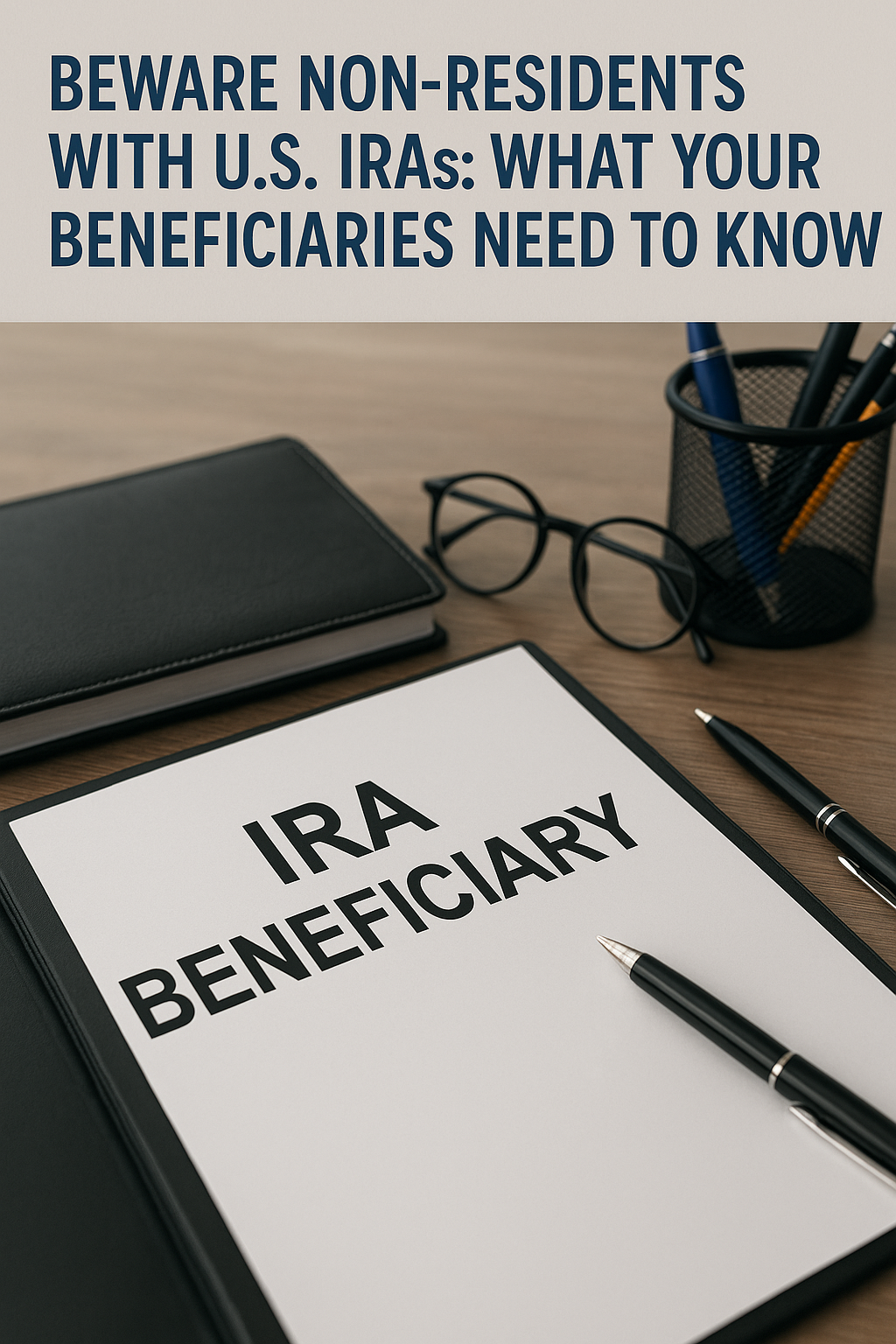 alt="Cross Border Retirement" class="wp-image-1063"/>
alt="Cross Border Retirement" class="wp-image-1063"/>Retirement planning is never a one-size-fits-all process, but for those who have lived, worked, or invested across borders, the complexity—and the risks—can be amplified.
While individuals who have only lived and worked in one country primarily contend with market-based risks like sequence of returns, cross-border retirees face a layered web of challenges and opportunities tied to currency fluctuations, tax regimes, and market conditions in multiple countries.
Understanding these risks and leveraging the potential benefits of international diversification requires a nuanced approach to financial planning and wealth planning solutions. Let’s explore the dynamics.
Risk 1: The “Double-Whammy” Effect ; Retirement Planning
For domestic-only retirees, one of the greatest risks to their portfolio is the sequence of market returns. A prolonged market downturn early in retirement can derail even the best-laid Retirement planning. When markets fall, retirees are forced to sell assets at depressed prices to cover living expenses, leaving less capital to recover when markets eventually rebound.
For cross-border retirees, this risk potentially doubles. Not only are they vulnerable to market fluctuations, but they must also navigate the unpredictable waters of currency exchange rates. If the retiree’s home currency’s deflation is more significantly against the currency of their new country of residence, the value of their income or savings can take a substantial hit. For instance:
- A market downturn in Canada coinciding with a weakening Canadian dollar against the U.S. dollar could significantly reduce the purchasing power of a Canadian retiree living in the United States.
- Similarly, retirees relying on U.S. assets but spending in euros could face a sharp decline in their effective income if the U.S. dollar weakens.
This “double-whammy” risk makes cross-border retirees more exposed to economic and geopolitical volatility, underscoring the importance of a carefully crafted financial plan.
Risk 2: Complexity of Tax and Regulatory Environments Retirement Planning
Navigating the tax implications of cross-border income and assets is no small feat. Countries often have conflicting tax rules, and what seems like an advantageous financial move in one jurisdiction can have unintended consequences in another. For example:
- Drawing from retirement accounts in a foreign country may trigger higher tax rates or penalties than expected.
- Currency gains or losses may have tax implications in one country that don’t exist in another.
Additionally, the lack of harmonization between tax systems can result in inefficient planning about tax rate in Canada vs US or, worse, double taxation if not properly managed.
Opportunity: Cross Border Diversification
While the risks of cross-border retirement planning are considerable, there’s another side to the coin: diversification. For retirees with income and assets spread across multiple currencies and countries, there is an inherent form of risk management at play.
- When one currency is weak, they can draw from assets denominated in a stronger currency, mitigating the impact of exchange rate fluctuations.
- Income streams from diverse economic regions may help retirees hedge against localized recessions or downturns.
This flexibility can be a powerful advantage—but it must be approached with care. While the ability to “pull from the strongest currency” sounds attractive, it may not always align with broader market conditions, investment strategies, or tax considerations.
The Bottom Line: Cross Border Financial Retirement Planning Requires Expertise
The complexity of cross-border retirement planning makes working with a professional essential. A well-informed advisor can help retirees:
- Mitigate Risks: Develop strategies to address market and currency fluctuations, sequence of returns, and tax obligations across multiple jurisdictions.
- Maximize Opportunities: Leverage the benefits of international diversification while balancing the tax and market dynamics of multiple countries.
- Retirement income strategies: To align withdrawals with market conditions, currency strengths, and long-term goals.
- Stay Compliant: Navigate the legal and regulatory complexities of cross-border finances, ensuring retirees avoid costly mistakes or penalties.
Retiring across borders can feel like walking a financial tightrope. The risks—market downturns, currency devaluations, and tax complexities—are real and require meticulous planning. However, with the right strategies and professional guidance, cross-border retirees can transform these challenges into opportunities for diversification and financial resilience.
Whether you’re preparing to retire abroad, splitting your time between countries, or managing assets across borders, the key is understanding how these factors interact and planning accordingly.
Cross-border financial planning is more than a checklist—it’s an ongoing process that ensures your retirement remains as secure and rewarding as you’ve envisioned. If you are crossing the 49th Parallel, get in touch with us on Instagram to talk about your situation. From the Desert to the Tundra, we are your cross-border retirement experts.
 class="attachment-post-thumbnail size-post-thumbnail wp-post-image" alt="What Happens to Canadian Registered Accounts When You Die as a Non-Resident" style="width:100%;height:100%;object-fit:cover;" srcset="https://49thparallelwealthmanagement.com/wp-content/uploads/2025/06/non-resident-death.png 1536w, https://49thparallelwealthmanagement.com/wp-content/uploads/2025/06/non-resident-death-300x200.png 300w, https://49thparallelwealthmanagement.com/wp-content/uploads/2025/06/non-resident-death-1024x683.png 1024w, https://49thparallelwealthmanagement.com/wp-content/uploads/2025/06/non-resident-death-768x512.png 768w, https://49thparallelwealthmanagement.com/wp-content/uploads/2025/06/non-resident-death-600x400.png 600w" sizes="(max-width: 1536px) 100vw, 1536px" />
class="attachment-post-thumbnail size-post-thumbnail wp-post-image" alt="What Happens to Canadian Registered Accounts When You Die as a Non-Resident" style="width:100%;height:100%;object-fit:cover;" srcset="https://49thparallelwealthmanagement.com/wp-content/uploads/2025/06/non-resident-death.png 1536w, https://49thparallelwealthmanagement.com/wp-content/uploads/2025/06/non-resident-death-300x200.png 300w, https://49thparallelwealthmanagement.com/wp-content/uploads/2025/06/non-resident-death-1024x683.png 1024w, https://49thparallelwealthmanagement.com/wp-content/uploads/2025/06/non-resident-death-768x512.png 768w, https://49thparallelwealthmanagement.com/wp-content/uploads/2025/06/non-resident-death-600x400.png 600w" sizes="(max-width: 1536px) 100vw, 1536px" />What Happens to Canadian Registered Accounts When You Die as a Non-Resident
 class="attachment-post-thumbnail size-post-thumbnail wp-post-image" alt="New Bill Offers Medicare Relief for Cross-Border Retirees" style="width:100%;height:100%;object-fit:cover;" srcset="https://49thparallelwealthmanagement.com/wp-content/uploads/2025/06/20250605_0722_Concerned-Couple-at-Hospital_simple_compose_01jx07f099fjw91e52w0g2sab3.png 1024w, https://49thparallelwealthmanagement.com/wp-content/uploads/2025/06/20250605_0722_Concerned-Couple-at-Hospital_simple_compose_01jx07f099fjw91e52w0g2sab3-200x300.png 200w, https://49thparallelwealthmanagement.com/wp-content/uploads/2025/06/20250605_0722_Concerned-Couple-at-Hospital_simple_compose_01jx07f099fjw91e52w0g2sab3-683x1024.png 683w, https://49thparallelwealthmanagement.com/wp-content/uploads/2025/06/20250605_0722_Concerned-Couple-at-Hospital_simple_compose_01jx07f099fjw91e52w0g2sab3-768x1152.png 768w, https://49thparallelwealthmanagement.com/wp-content/uploads/2025/06/20250605_0722_Concerned-Couple-at-Hospital_simple_compose_01jx07f099fjw91e52w0g2sab3-600x900.png 600w" sizes="(max-width: 1024px) 100vw, 1024px" />
class="attachment-post-thumbnail size-post-thumbnail wp-post-image" alt="New Bill Offers Medicare Relief for Cross-Border Retirees" style="width:100%;height:100%;object-fit:cover;" srcset="https://49thparallelwealthmanagement.com/wp-content/uploads/2025/06/20250605_0722_Concerned-Couple-at-Hospital_simple_compose_01jx07f099fjw91e52w0g2sab3.png 1024w, https://49thparallelwealthmanagement.com/wp-content/uploads/2025/06/20250605_0722_Concerned-Couple-at-Hospital_simple_compose_01jx07f099fjw91e52w0g2sab3-200x300.png 200w, https://49thparallelwealthmanagement.com/wp-content/uploads/2025/06/20250605_0722_Concerned-Couple-at-Hospital_simple_compose_01jx07f099fjw91e52w0g2sab3-683x1024.png 683w, https://49thparallelwealthmanagement.com/wp-content/uploads/2025/06/20250605_0722_Concerned-Couple-at-Hospital_simple_compose_01jx07f099fjw91e52w0g2sab3-768x1152.png 768w, https://49thparallelwealthmanagement.com/wp-content/uploads/2025/06/20250605_0722_Concerned-Couple-at-Hospital_simple_compose_01jx07f099fjw91e52w0g2sab3-600x900.png 600w" sizes="(max-width: 1024px) 100vw, 1024px" />New Bill Offers Medicare Relief for Cross-Border Retirees
 class="attachment-post-thumbnail size-post-thumbnail wp-post-image" alt="Beware: Non-Residents with U.S. IRAs – What Your Beneficiaries Need to Know" style="width:100%;height:100%;object-fit:cover;" srcset="https://49thparallelwealthmanagement.com/wp-content/uploads/2025/06/Ira-Beneficiuary.png 1024w, https://49thparallelwealthmanagement.com/wp-content/uploads/2025/06/Ira-Beneficiuary-200x300.png 200w, https://49thparallelwealthmanagement.com/wp-content/uploads/2025/06/Ira-Beneficiuary-683x1024.png 683w" sizes="(max-width: 1024px) 100vw, 1024px" />
class="attachment-post-thumbnail size-post-thumbnail wp-post-image" alt="Beware: Non-Residents with U.S. IRAs – What Your Beneficiaries Need to Know" style="width:100%;height:100%;object-fit:cover;" srcset="https://49thparallelwealthmanagement.com/wp-content/uploads/2025/06/Ira-Beneficiuary.png 1024w, https://49thparallelwealthmanagement.com/wp-content/uploads/2025/06/Ira-Beneficiuary-200x300.png 200w, https://49thparallelwealthmanagement.com/wp-content/uploads/2025/06/Ira-Beneficiuary-683x1024.png 683w" sizes="(max-width: 1024px) 100vw, 1024px" />Beware: Non-Residents with U.S. IRAs – What Your Beneficiaries Need to Know



